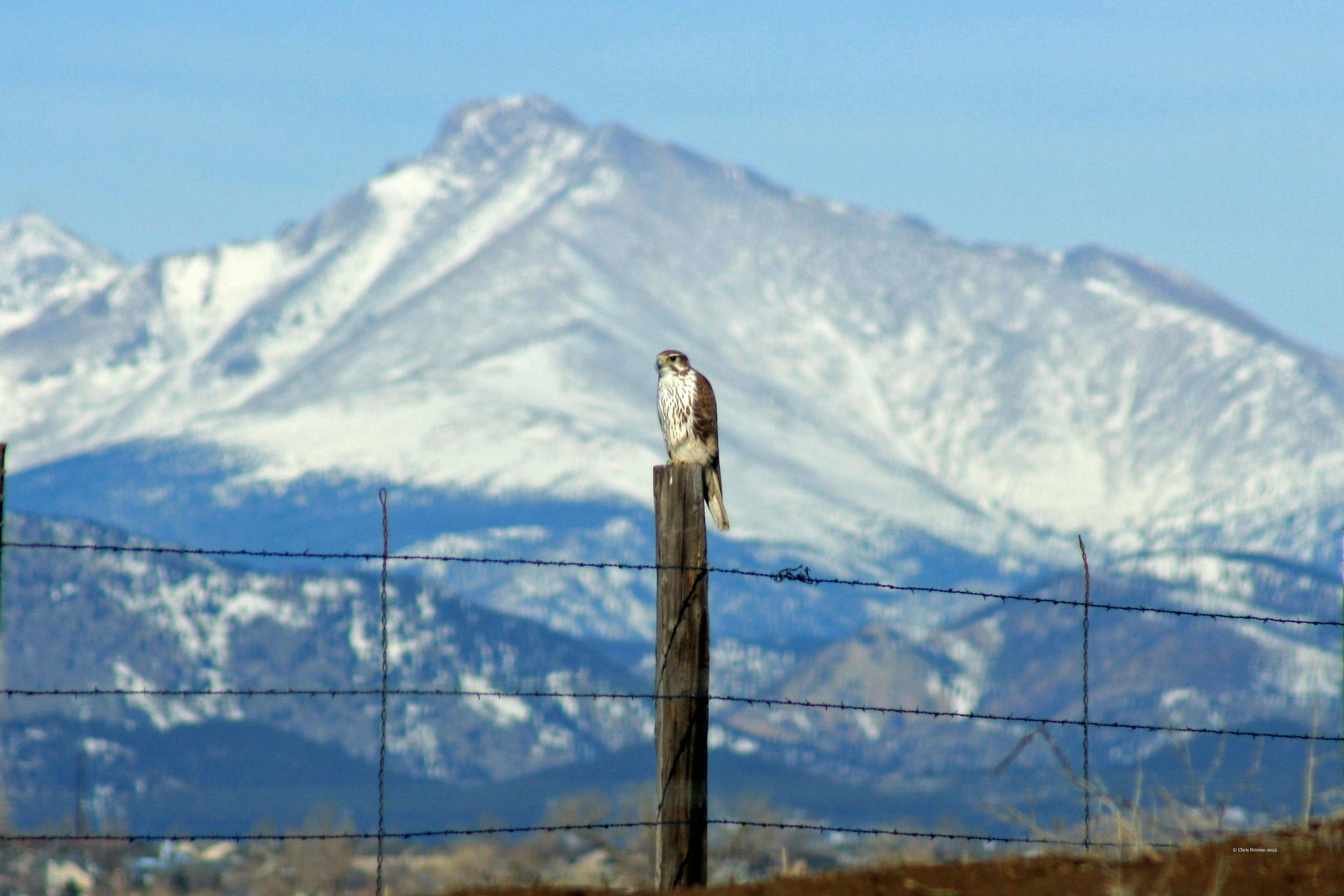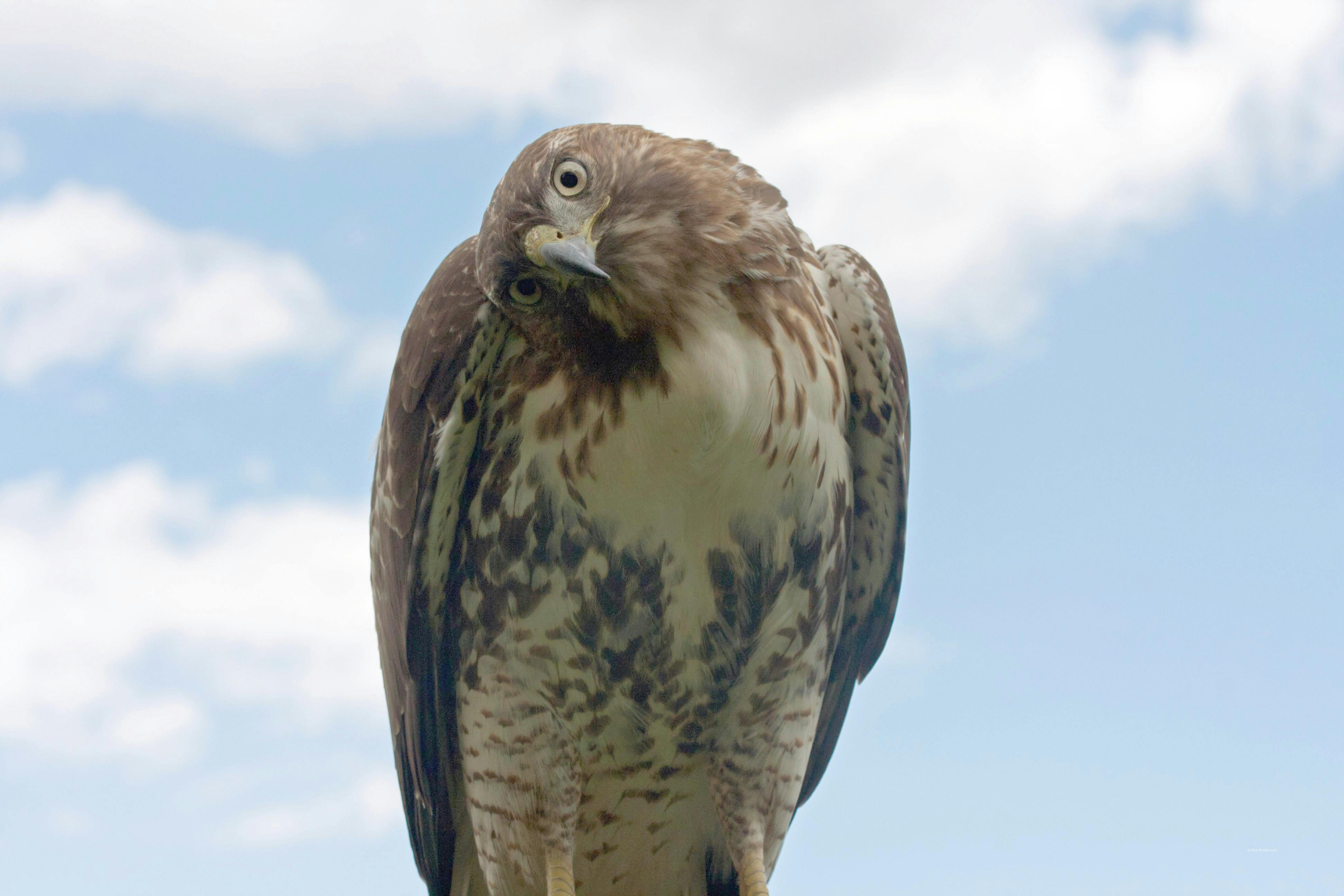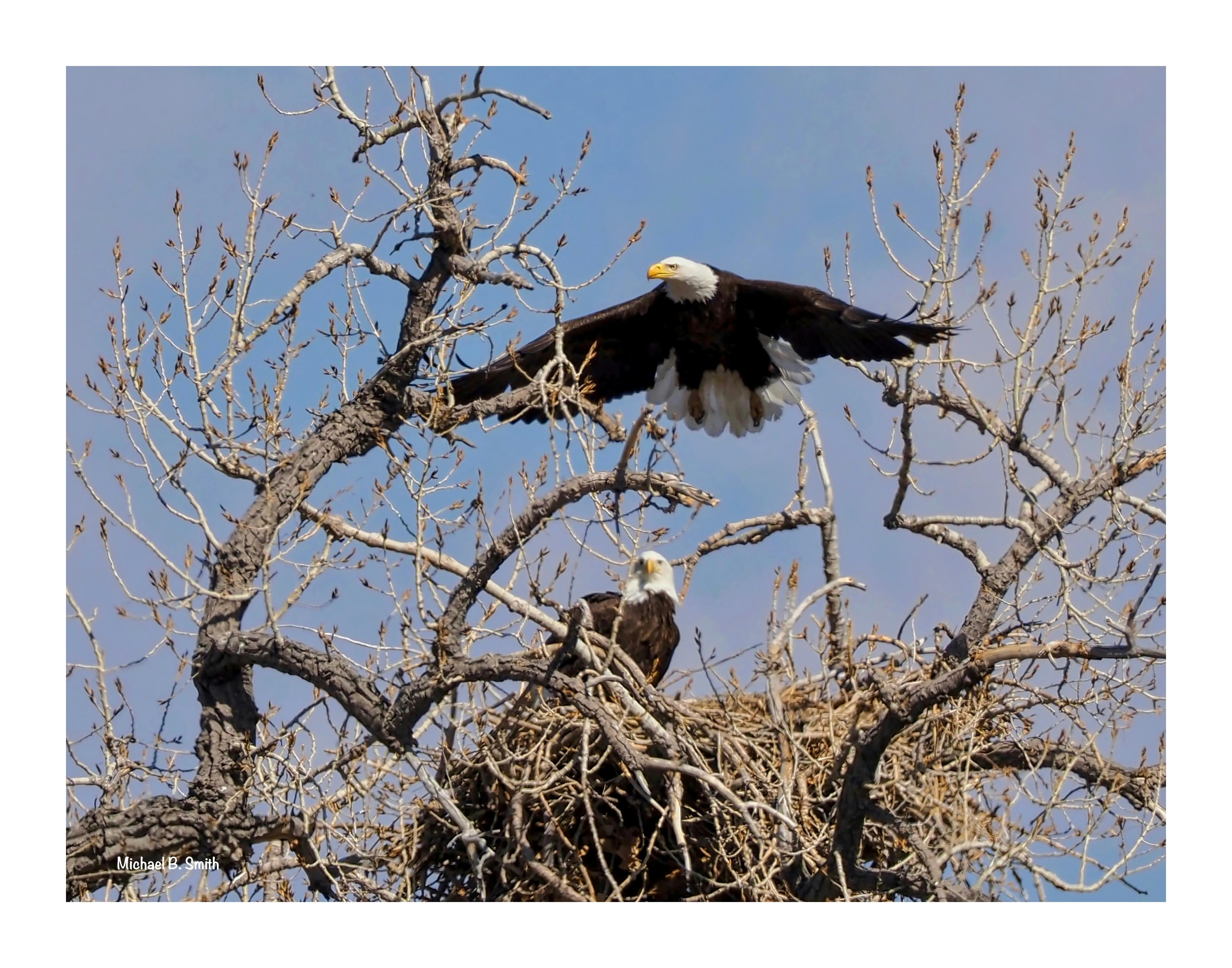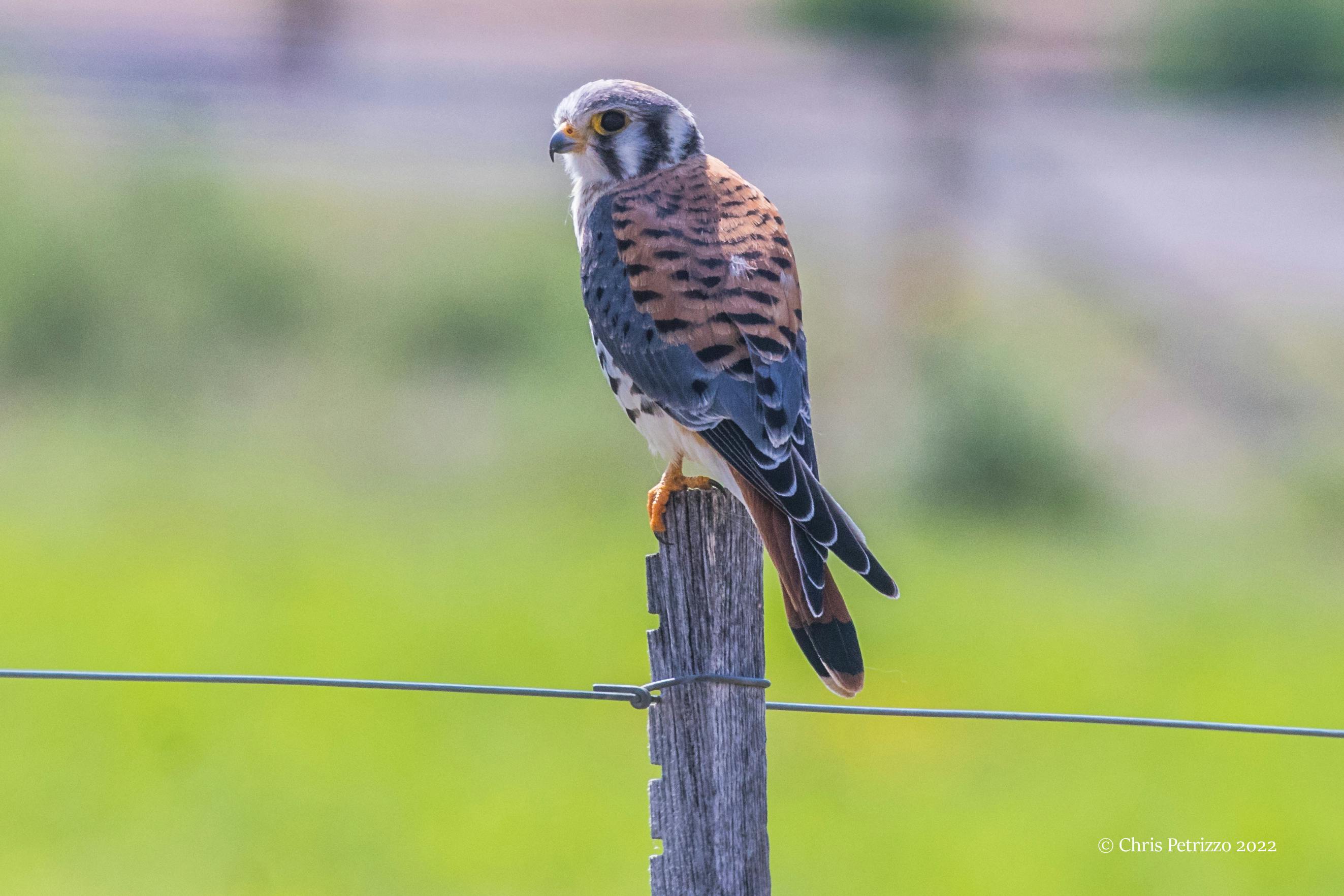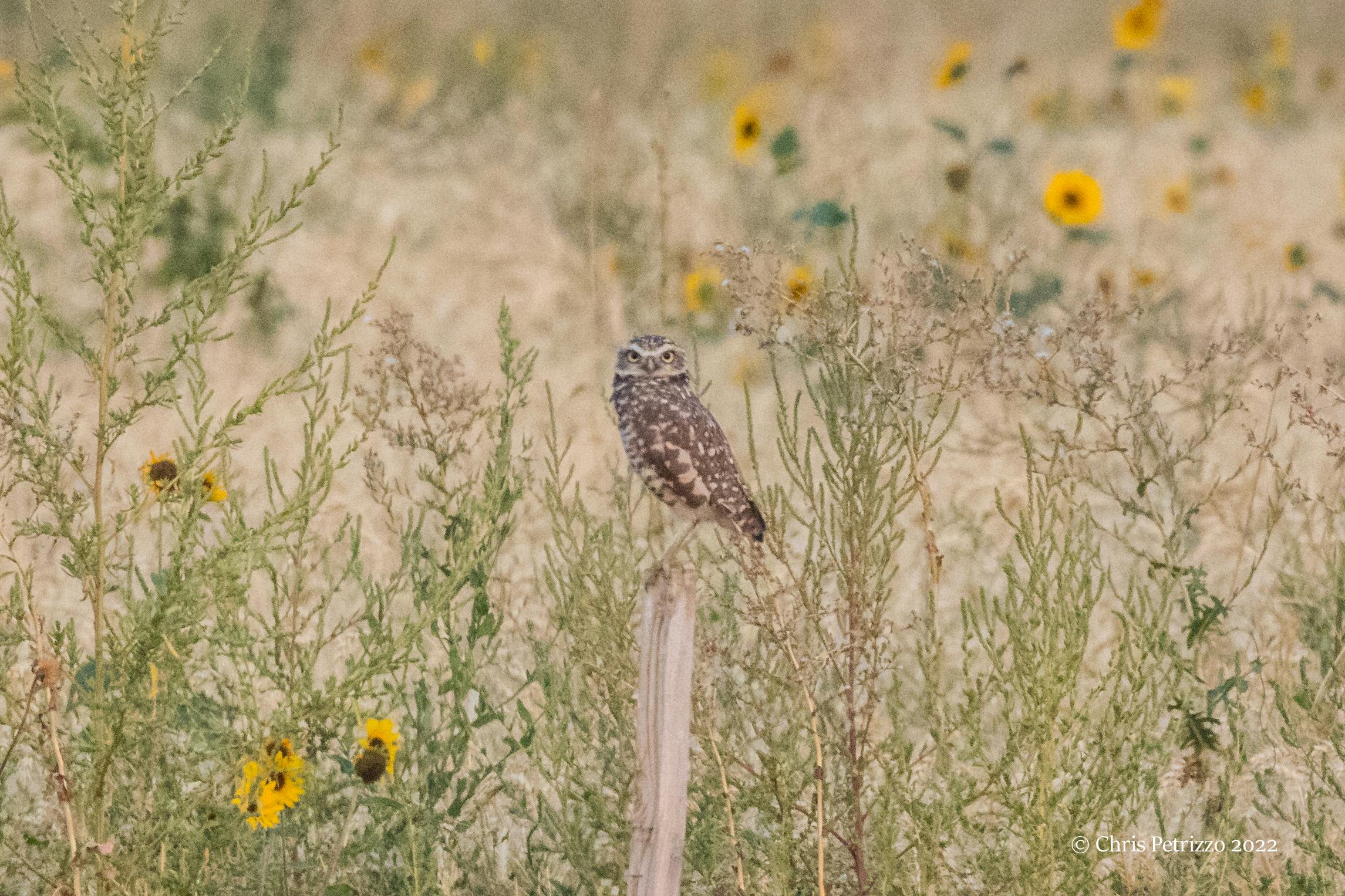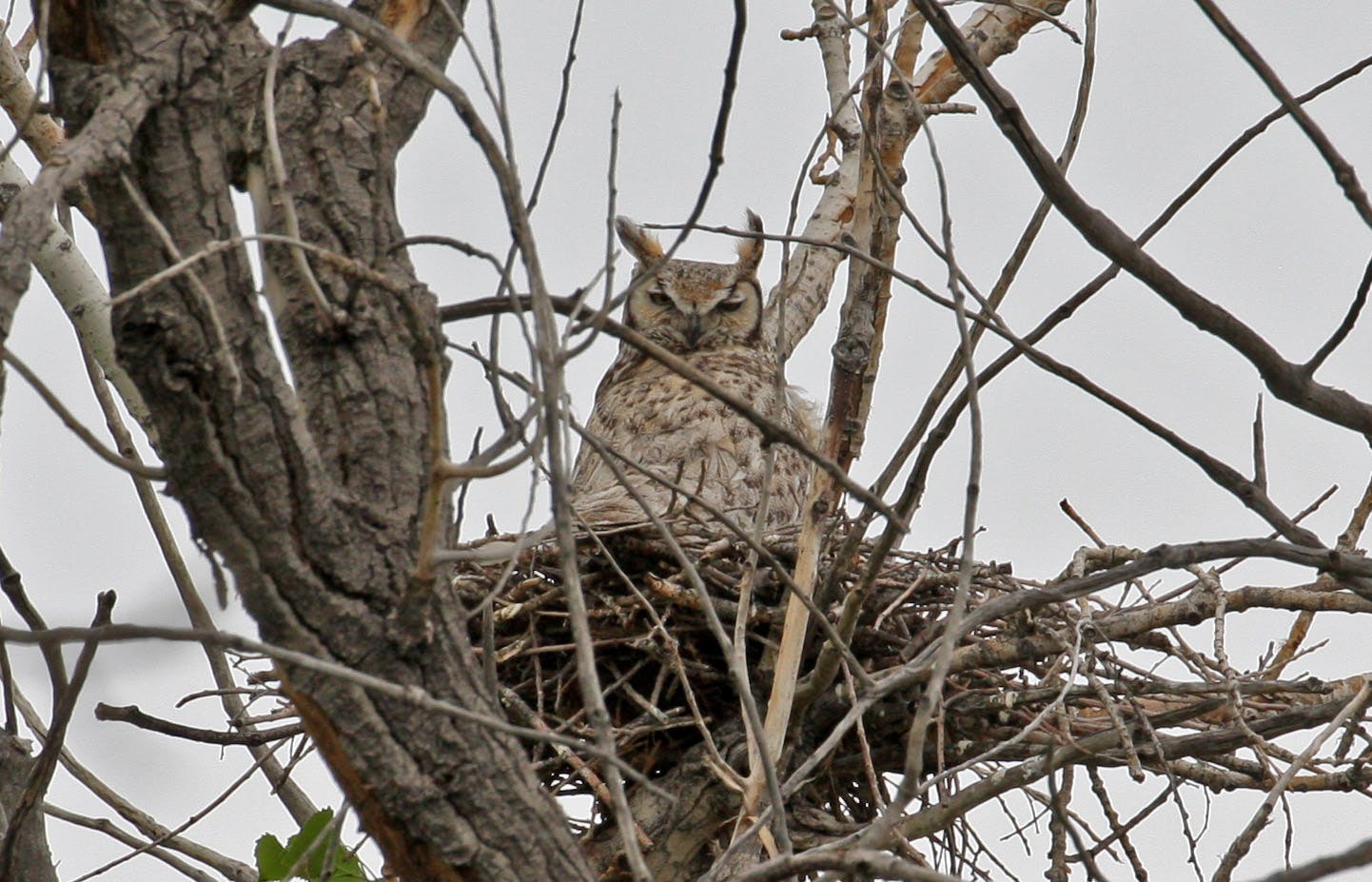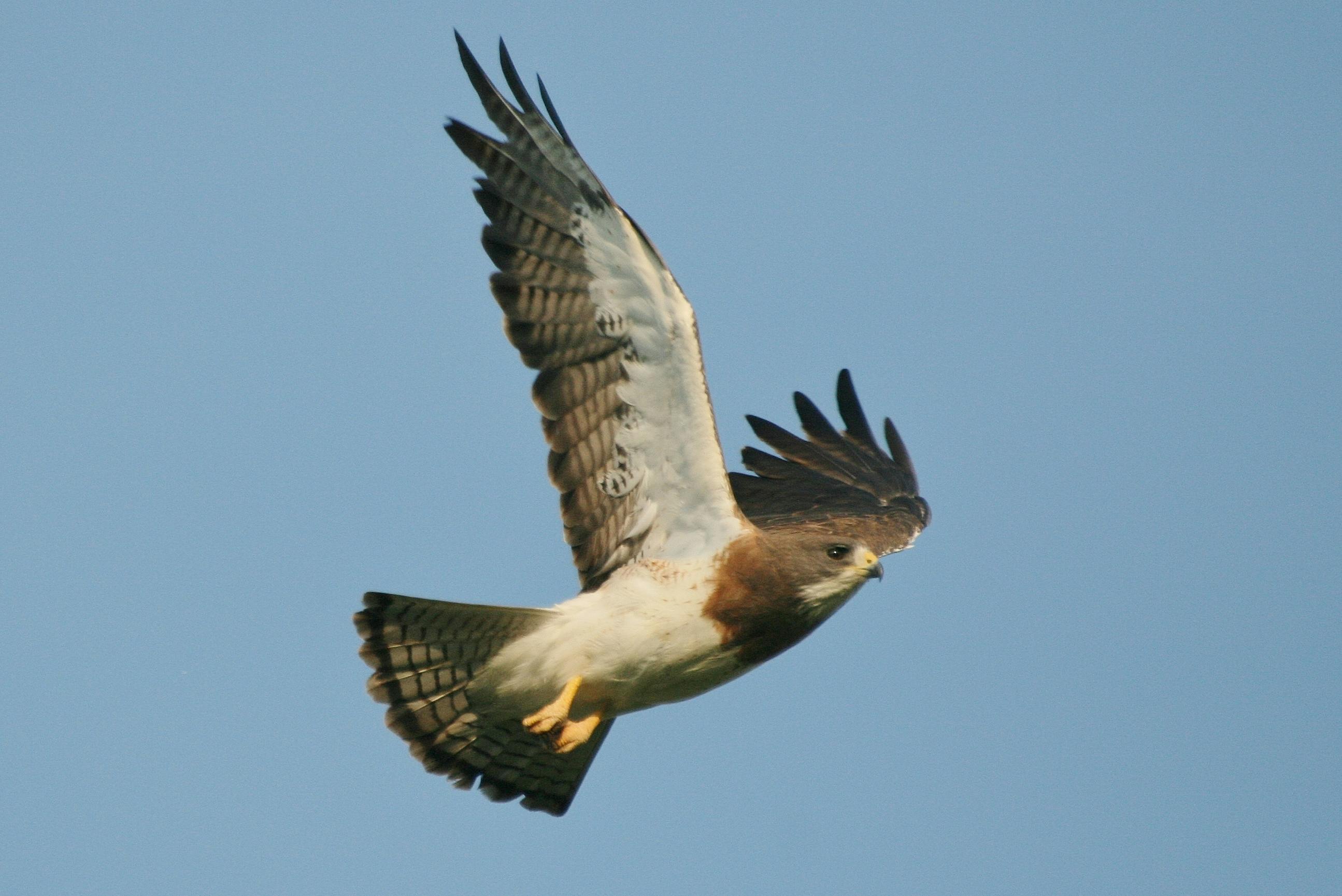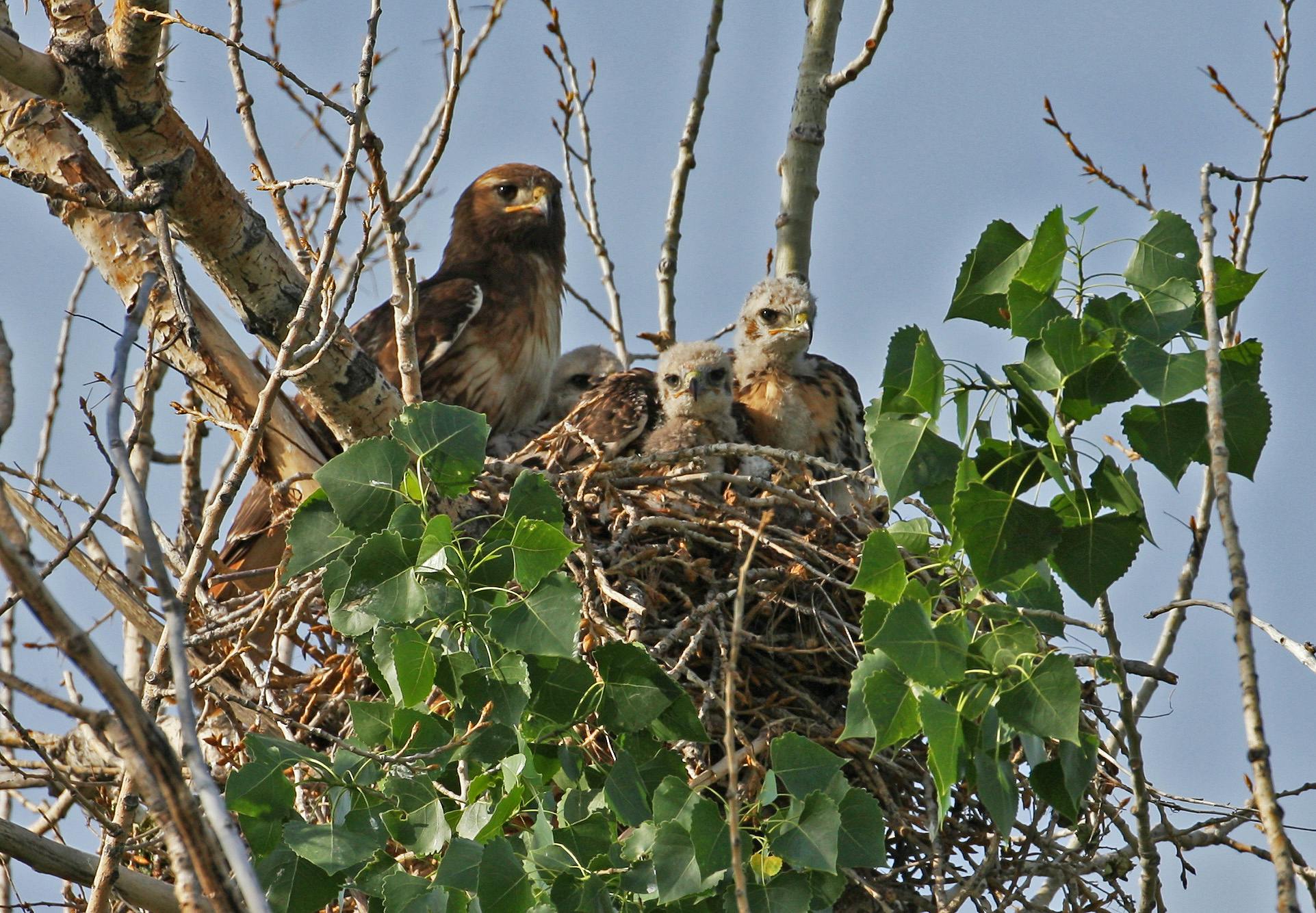Broomfield Raptor Management Plan
ARCHIVED
The Raptor Management Plan is approved! On Aug. 27, 2024 Broomfield City Council approved the Raptor Management Plan. Open Space & Trails staff and volunteers will begin to implement the plan as outlined.
You can review the project information below. For more information, please visit the Broomfield Open Space and Trails Plans webpage or contact Open Space & Trails staff at openspace@broomfield.org
Project Summary
Broomfield is fortunate to have a variety of active raptor populations thriving in a suburban setting. However, these majestic birds, which include species like Bald Eagles, Great Horned Owls and Red-tailed Hawks, are sensitive to human disturbances. Open Space and Trails Staff, along with a team of ecological consultants from Smith Environmental and Engineering, developed a Raptor Management Plan. This plan seeks to protect raptors, identify and enhance raptor habitat in Broomfield, and recommend best practices to promote raptor breeding and nesting success.
Public Engagement Summary
The team presented the Raptor Plan Overview in September 2021 and the Raptor Plan Draft Phase, a progress report and outlined plan, in October of 2022. The Draft Final Plan was presented to and approved by the Broomfield Open Space and Trails Committee on June 27, 2024; the Final Plan was approved by the Broomfield City Council on August 27, 2024. Please visit the Broomfield City Council webpage for more information about the meeting.
The Broomfield City Council approved the Final Plan on August 27, 2024.
Click Here to view the Final Plan.
Click Here to view the Appendices.
Click Here to view the Memo to City Council.
Raptor Management Plan Outline:
- Introduction
- Raptor Biology
- Raptor Protection
- Public Engagement
- Causes of Raptor Fatality
- Priority Habitat in Broomfield
- Plan Recommendations
Broomfield Raptor Breeding Guide:
Species | Jan | Feb | Mar | Apr | May | Jun | Jul | Aug | Sep | Oct | Nov | Dec | Incubation Period |
Bald Eagle | * | * | * | * | * | 35 days | |||||||
Golden Eagle | * | * | * | * | 41-45 days | ||||||||
Osprey | * | * | * | * | 38 days | ||||||||
Cooper’s Hawk | * | * | * | 36 days | |||||||||
Sharp-shinned Hawk | * | * | * | * | 30-35 days | ||||||||
Red-tailed Hawk | * | * | * | * | 28 days | ||||||||
Ferruginous Hawk | * | * | * | 32 days | |||||||||
Swainson’s Hawk | * | * | * | * | 35 days | ||||||||
Northern Harrier | * | * | 24-30 days | ||||||||||
American Kestrel | * | * | * | * | * | 29- 31 days | |||||||
Prairie Falcon | * | * | * | 29-39 days | |||||||||
Burrowing Owl | * | * | * | * | 30-37 days | ||||||||
Great-horned Owl | * | * | * | * | * | * | * | 28-30 days | |||||
Eastern Screech Owl | * | * | * | 26- 34 days | |||||||||
Common Barn Owl | * | * | * | * | * | 30 days | |||||||
Turkey Vulture | * | * | * | 38-41 days |
*Shaded cells represent the active nesting period; asterisks represent the period of nests with young.
Project Summary
Broomfield is fortunate to have a variety of active raptor populations thriving in a suburban setting. However, these majestic birds, which include species like Bald Eagles, Great Horned Owls and Red-tailed Hawks, are sensitive to human disturbances. Open Space and Trails Staff, along with a team of ecological consultants from Smith Environmental and Engineering, developed a Raptor Management Plan. This plan seeks to protect raptors, identify and enhance raptor habitat in Broomfield, and recommend best practices to promote raptor breeding and nesting success.
Public Engagement Summary
The team presented the Raptor Plan Overview in September 2021 and the Raptor Plan Draft Phase, a progress report and outlined plan, in October of 2022. The Draft Final Plan was presented to and approved by the Broomfield Open Space and Trails Committee on June 27, 2024; the Final Plan was approved by the Broomfield City Council on August 27, 2024. Please visit the Broomfield City Council webpage for more information about the meeting.
The Broomfield City Council approved the Final Plan on August 27, 2024.
Click Here to view the Final Plan.
Click Here to view the Appendices.
Click Here to view the Memo to City Council.
Raptor Management Plan Outline:
- Introduction
- Raptor Biology
- Raptor Protection
- Public Engagement
- Causes of Raptor Fatality
- Priority Habitat in Broomfield
- Plan Recommendations
Broomfield Raptor Breeding Guide:
Species | Jan | Feb | Mar | Apr | May | Jun | Jul | Aug | Sep | Oct | Nov | Dec | Incubation Period |
Bald Eagle | * | * | * | * | * | 35 days | |||||||
Golden Eagle | * | * | * | * | 41-45 days | ||||||||
Osprey | * | * | * | * | 38 days | ||||||||
Cooper’s Hawk | * | * | * | 36 days | |||||||||
Sharp-shinned Hawk | * | * | * | * | 30-35 days | ||||||||
Red-tailed Hawk | * | * | * | * | 28 days | ||||||||
Ferruginous Hawk | * | * | * | 32 days | |||||||||
Swainson’s Hawk | * | * | * | * | 35 days | ||||||||
Northern Harrier | * | * | 24-30 days | ||||||||||
American Kestrel | * | * | * | * | * | 29- 31 days | |||||||
Prairie Falcon | * | * | * | 29-39 days | |||||||||
Burrowing Owl | * | * | * | * | 30-37 days | ||||||||
Great-horned Owl | * | * | * | * | * | * | * | 28-30 days | |||||
Eastern Screech Owl | * | * | * | 26- 34 days | |||||||||
Common Barn Owl | * | * | * | * | * | 30 days | |||||||
Turkey Vulture | * | * | * | 38-41 days |
*Shaded cells represent the active nesting period; asterisks represent the period of nests with young.
ARCHIVED
The Raptor Management Plan is approved! On Aug. 27, 2024 Broomfield City Council approved the Raptor Management Plan. Open Space & Trails staff and volunteers will begin to implement the plan as outlined.
You can review the project information below. For more information, please visit the Broomfield Open Space and Trails Plans webpage or contact Open Space & Trails staff at openspace@broomfield.org
-
Share Do low and loud flying prop planes from the Jeffco airport discourage/disrupt raptors in Broomfield? on Facebook Share Do low and loud flying prop planes from the Jeffco airport discourage/disrupt raptors in Broomfield? on Twitter Share Do low and loud flying prop planes from the Jeffco airport discourage/disrupt raptors in Broomfield? on Linkedin Email Do low and loud flying prop planes from the Jeffco airport discourage/disrupt raptors in Broomfield? link
Do low and loud flying prop planes from the Jeffco airport discourage/disrupt raptors in Broomfield?
Colorado13biker@gmail.com asked over 1 year agoThank you for your question. The Jeffco airport is outside of the Broomfield boundaries and is not a part of the Raptor Management Plan. However, the plan does include ways to promote raptor habitat on specific Broomfield properties, including Great Western Open Space which is near the airport. Recommendations within the Raptor Management Plan for Great Western include preserving the prairie dog colony as a prey source, continuing to restrict public use, especially for dogs, and restoring native vegetation where feasible both inside and outside of the prairie dog colony north of the reservoir to promote existing wildlife habitat and wildlife use.
-
Share Is there any plan to catalog and count the Broomfield raptor population? Just as a suggestion, you could call on individuals and organizations to conduct spotting expeditions, equipping themselves with notebooks, binoculars and cameras, and providing them with a basic photo guide with pictures and descriptions of each kind of raptor in the Broomfield area. Then they can go out on their own, find and photograph any/all raptors they can, as clearly as they can, documenting whether the birds were in a nest, in flight or perched. By comparing the markings on birds in photographs, you could determine which are residents what their territory is, and the potential for new generations, as well as how many there are. Using a volunteer taskforce, and encouraging businesses, churches and organizations to use the excursions for team building or educational exercises, challenges between groups, maybe a contest for the best captured images or largest area covered, you could gather some really essential information regarding the raptor population, and engage the community to encourage conservation. on Facebook Share Is there any plan to catalog and count the Broomfield raptor population? Just as a suggestion, you could call on individuals and organizations to conduct spotting expeditions, equipping themselves with notebooks, binoculars and cameras, and providing them with a basic photo guide with pictures and descriptions of each kind of raptor in the Broomfield area. Then they can go out on their own, find and photograph any/all raptors they can, as clearly as they can, documenting whether the birds were in a nest, in flight or perched. By comparing the markings on birds in photographs, you could determine which are residents what their territory is, and the potential for new generations, as well as how many there are. Using a volunteer taskforce, and encouraging businesses, churches and organizations to use the excursions for team building or educational exercises, challenges between groups, maybe a contest for the best captured images or largest area covered, you could gather some really essential information regarding the raptor population, and engage the community to encourage conservation. on Twitter Share Is there any plan to catalog and count the Broomfield raptor population? Just as a suggestion, you could call on individuals and organizations to conduct spotting expeditions, equipping themselves with notebooks, binoculars and cameras, and providing them with a basic photo guide with pictures and descriptions of each kind of raptor in the Broomfield area. Then they can go out on their own, find and photograph any/all raptors they can, as clearly as they can, documenting whether the birds were in a nest, in flight or perched. By comparing the markings on birds in photographs, you could determine which are residents what their territory is, and the potential for new generations, as well as how many there are. Using a volunteer taskforce, and encouraging businesses, churches and organizations to use the excursions for team building or educational exercises, challenges between groups, maybe a contest for the best captured images or largest area covered, you could gather some really essential information regarding the raptor population, and engage the community to encourage conservation. on Linkedin Email Is there any plan to catalog and count the Broomfield raptor population? Just as a suggestion, you could call on individuals and organizations to conduct spotting expeditions, equipping themselves with notebooks, binoculars and cameras, and providing them with a basic photo guide with pictures and descriptions of each kind of raptor in the Broomfield area. Then they can go out on their own, find and photograph any/all raptors they can, as clearly as they can, documenting whether the birds were in a nest, in flight or perched. By comparing the markings on birds in photographs, you could determine which are residents what their territory is, and the potential for new generations, as well as how many there are. Using a volunteer taskforce, and encouraging businesses, churches and organizations to use the excursions for team building or educational exercises, challenges between groups, maybe a contest for the best captured images or largest area covered, you could gather some really essential information regarding the raptor population, and engage the community to encourage conservation. link
Is there any plan to catalog and count the Broomfield raptor population? Just as a suggestion, you could call on individuals and organizations to conduct spotting expeditions, equipping themselves with notebooks, binoculars and cameras, and providing them with a basic photo guide with pictures and descriptions of each kind of raptor in the Broomfield area. Then they can go out on their own, find and photograph any/all raptors they can, as clearly as they can, documenting whether the birds were in a nest, in flight or perched. By comparing the markings on birds in photographs, you could determine which are residents what their territory is, and the potential for new generations, as well as how many there are. Using a volunteer taskforce, and encouraging businesses, churches and organizations to use the excursions for team building or educational exercises, challenges between groups, maybe a contest for the best captured images or largest area covered, you could gather some really essential information regarding the raptor population, and engage the community to encourage conservation.
BillyBearJarrett asked almost 4 years agoThank you very much for this suggestion. We are discussing this with our project team and reviewing the ways that something like this can be accomplished. At this time we do have some elements of this in place, including mapping of many nesting sites, access to state mapping through Colorado Parks and Wildlife, and information provided by biologists that work on projects throughout our community. There is also a lot of information available on private online sites like eBird and iNaturalist (we do have our own page 'Broomfield Naturalists'). We are definitely interested in having 'citizen scientists' in Broomfield and increasing awareness and education around our local raptors. Two local opportunities that may be of interest are the Broomfield Bird Club, and the local Eagle Watch volunteer program.
-
Share Are there any opportunities to volunteer to support the program? on Facebook Share Are there any opportunities to volunteer to support the program? on Twitter Share Are there any opportunities to volunteer to support the program? on Linkedin Email Are there any opportunities to volunteer to support the program? link
Are there any opportunities to volunteer to support the program?
krhyser asked almost 4 years agoThank you very much for your question and interest in volunteering. We don't have a specific volunteer program for the raptor plan, but we do have some related volunteer opportunities. These volunteer opportunities include the Eagle Watch program, which provides monitoring of an active local bald eagle nest. Information on Eagle Watch and other volunteer opportunities can be found on our Open Space and Trails website. You can also contact Open Space and Trails staff directly by emailing openspace@broomfield.org.
-
Share Please keep me on your email list for updates on Facebook Share Please keep me on your email list for updates on Twitter Share Please keep me on your email list for updates on Linkedin Email Please keep me on your email list for updates link
Please keep me on your email list for updates
CLingo asked almost 3 years agoThank you for your interest in the Raptor Management plan. We do not currently have a specific mailing list for this project, but all updates to the project are posted here on the Broomfield Voice page and are also posted in our monthly Open Space and Trails community newsletter. To view and to sign up for the newsletter, sign up with your information, select "Open Space and Trails Monthly Newsletter" (along with any other CCOB newsletters that you would like to sign up for) and click submit form. -
Share How is the increased development with reduction of open space in the neighborhood north of 144th impacting the birds? on Facebook Share How is the increased development with reduction of open space in the neighborhood north of 144th impacting the birds? on Twitter Share How is the increased development with reduction of open space in the neighborhood north of 144th impacting the birds? on Linkedin Email How is the increased development with reduction of open space in the neighborhood north of 144th impacting the birds? link
How is the increased development with reduction of open space in the neighborhood north of 144th impacting the birds?
Nicky asked almost 2 years agoThank you for your inquiry about the Broomfield Raptor Management Plan. We would like to address this question directly, but will need a few more details. Could you please email openspace@broomfield.org with a more specific location of the area that you are referring to, as there are many Broomfield neighborhoods north of 144th Avenue. There has not been any decrease in designated open space north of 144th in Broomfield, but there are several development projects taking place on previously undeveloped land.
-
Share There are a mating pair of Harriers that live and roost on the NE corner of the 154th and Huron intersection in the Broomfield Open Space. We love them because they have claimed airspace over our farm as their territory and they chase the redtails away from our chickens. The red tails nest about a block north of us also along Huron and the open space. Is there any way to minimize nesting/roosting disturbances when the Huron expansion in this section occurs? on Facebook Share There are a mating pair of Harriers that live and roost on the NE corner of the 154th and Huron intersection in the Broomfield Open Space. We love them because they have claimed airspace over our farm as their territory and they chase the redtails away from our chickens. The red tails nest about a block north of us also along Huron and the open space. Is there any way to minimize nesting/roosting disturbances when the Huron expansion in this section occurs? on Twitter Share There are a mating pair of Harriers that live and roost on the NE corner of the 154th and Huron intersection in the Broomfield Open Space. We love them because they have claimed airspace over our farm as their territory and they chase the redtails away from our chickens. The red tails nest about a block north of us also along Huron and the open space. Is there any way to minimize nesting/roosting disturbances when the Huron expansion in this section occurs? on Linkedin Email There are a mating pair of Harriers that live and roost on the NE corner of the 154th and Huron intersection in the Broomfield Open Space. We love them because they have claimed airspace over our farm as their territory and they chase the redtails away from our chickens. The red tails nest about a block north of us also along Huron and the open space. Is there any way to minimize nesting/roosting disturbances when the Huron expansion in this section occurs? link
There are a mating pair of Harriers that live and roost on the NE corner of the 154th and Huron intersection in the Broomfield Open Space. We love them because they have claimed airspace over our farm as their territory and they chase the redtails away from our chickens. The red tails nest about a block north of us also along Huron and the open space. Is there any way to minimize nesting/roosting disturbances when the Huron expansion in this section occurs?
Steph asked almost 3 years agoThank you for your comment, and sharing your experience with the nesting Harriers in your neighborhood. They are magnificant raptors and we are happy to hear of the positive impact that are having for your property and neighborhood. There are plans for widening and construction activities on Huron Street in this area, but that work would not begin until late 2023, at the earliest. There should be no impacts to the nesting season out there this year. When the construction project is slated to begin, there will be an environmental letter and review required before the work begins. Any surrounding nests will be identified and mitigation measures will take place if the nest is active to avoid impacts per State and Federal regulations.
-
Share I spotted a peregrine falcon twice from the kitchen window- my house backs to the 13th hole of the eagle golf course. Could I be mistaken I don’t see them listed. on Facebook Share I spotted a peregrine falcon twice from the kitchen window- my house backs to the 13th hole of the eagle golf course. Could I be mistaken I don’t see them listed. on Twitter Share I spotted a peregrine falcon twice from the kitchen window- my house backs to the 13th hole of the eagle golf course. Could I be mistaken I don’t see them listed. on Linkedin Email I spotted a peregrine falcon twice from the kitchen window- my house backs to the 13th hole of the eagle golf course. Could I be mistaken I don’t see them listed. link
I spotted a peregrine falcon twice from the kitchen window- my house backs to the 13th hole of the eagle golf course. Could I be mistaken I don’t see them listed.
SallyJButler asked almost 3 years agoYes, Peregrine Falcons are a species that can be found in Broomfield and they are listed in our full raptor management plan. They are not found in the breeding guide above as the table is an example of a breeding guide that will be included in the raptor plan in the sections concerning breeding. Peregrine Falcons will nest and dwell in cliff settings, so they are unlikely to breed in Broomfield. However, they will still use Broomfield Open Spaces to forage, so they are listed in our raptor management plan. The plan will not include all raptor species that could be encountered in Broomfield, but will make an effort to include species that 1) breed and 2) forage in Broomfield. Find more information on Peregrine Falcons here.
-
Share How can I attract more hawks to hunt down the pesky rabbits in my lawn and garden? on Facebook Share How can I attract more hawks to hunt down the pesky rabbits in my lawn and garden? on Twitter Share How can I attract more hawks to hunt down the pesky rabbits in my lawn and garden? on Linkedin Email How can I attract more hawks to hunt down the pesky rabbits in my lawn and garden? link
How can I attract more hawks to hunt down the pesky rabbits in my lawn and garden?
Elmer Fudd asked almost 4 years agoThe hawks and owls are pretty good at this already, although they can't always keep up with the rabbits! Hawks and owls both hunt primarily from above and use perches, so having trees and even rooftops with good sightlines helps. Also, the Broomfield Wildlife Masters have some good ideas and strategies to limit rabbits in lawns and gardens. They are local volunteers with lots of knowledge in answering backyard wildlife questions.
-
Share Have you contacted and are you working closely with the Birds of Prey Foundation here in Broomfield? If not, you must. They will bring to the table a long legacy of hands-on interaction on many levels not only in the Broomfield area but habitats and "challenges" of surrounding jurisdictions. It is of paramount importance that you work synergistically with them to best ensure your success. I suggest that donation commitments to them be of the highest on-going priority for you, both long and short term budget planning. on Facebook Share Have you contacted and are you working closely with the Birds of Prey Foundation here in Broomfield? If not, you must. They will bring to the table a long legacy of hands-on interaction on many levels not only in the Broomfield area but habitats and "challenges" of surrounding jurisdictions. It is of paramount importance that you work synergistically with them to best ensure your success. I suggest that donation commitments to them be of the highest on-going priority for you, both long and short term budget planning. on Twitter Share Have you contacted and are you working closely with the Birds of Prey Foundation here in Broomfield? If not, you must. They will bring to the table a long legacy of hands-on interaction on many levels not only in the Broomfield area but habitats and "challenges" of surrounding jurisdictions. It is of paramount importance that you work synergistically with them to best ensure your success. I suggest that donation commitments to them be of the highest on-going priority for you, both long and short term budget planning. on Linkedin Email Have you contacted and are you working closely with the Birds of Prey Foundation here in Broomfield? If not, you must. They will bring to the table a long legacy of hands-on interaction on many levels not only in the Broomfield area but habitats and "challenges" of surrounding jurisdictions. It is of paramount importance that you work synergistically with them to best ensure your success. I suggest that donation commitments to them be of the highest on-going priority for you, both long and short term budget planning. link
Have you contacted and are you working closely with the Birds of Prey Foundation here in Broomfield? If not, you must. They will bring to the table a long legacy of hands-on interaction on many levels not only in the Broomfield area but habitats and "challenges" of surrounding jurisdictions. It is of paramount importance that you work synergistically with them to best ensure your success. I suggest that donation commitments to them be of the highest on-going priority for you, both long and short term budget planning.
JSMOSBY asked almost 4 years agoYes! We are working closely with the Birds of Prey Foundation on this project. We greatly value their input and have met with them about this plan (and we have delivered injured birds there ourselves). They are a key stakeholder in this process and we will continue to coordinate with their staff.
-
Share We have had hawks and owls nesting in the trees along Walnut Creek in Southwest Broomfield adjacent to the Skyestone development for multiple years. There are multiple proposed Developments (Simms Technology Park, Southpointe) along the creek path- how will the raptor management plan be used to constrain potential developments that would reduce raptor habitats? on Facebook Share We have had hawks and owls nesting in the trees along Walnut Creek in Southwest Broomfield adjacent to the Skyestone development for multiple years. There are multiple proposed Developments (Simms Technology Park, Southpointe) along the creek path- how will the raptor management plan be used to constrain potential developments that would reduce raptor habitats? on Twitter Share We have had hawks and owls nesting in the trees along Walnut Creek in Southwest Broomfield adjacent to the Skyestone development for multiple years. There are multiple proposed Developments (Simms Technology Park, Southpointe) along the creek path- how will the raptor management plan be used to constrain potential developments that would reduce raptor habitats? on Linkedin Email We have had hawks and owls nesting in the trees along Walnut Creek in Southwest Broomfield adjacent to the Skyestone development for multiple years. There are multiple proposed Developments (Simms Technology Park, Southpointe) along the creek path- how will the raptor management plan be used to constrain potential developments that would reduce raptor habitats? link
We have had hawks and owls nesting in the trees along Walnut Creek in Southwest Broomfield adjacent to the Skyestone development for multiple years. There are multiple proposed Developments (Simms Technology Park, Southpointe) along the creek path- how will the raptor management plan be used to constrain potential developments that would reduce raptor habitats?
Dave F asked about 4 years agoThis plan will carefully review raptor habitat and buffer areas for nesting sites in Broomfield near development, but any legal constraints over future development is beyond the immediate scope of this plan, and would need to be coordinated within the framework of state and federal laws, zoning, and property development rights. The plan will assess habitat and attempt to identify the sources of conflict, injury, disease or general stress on raptors, and develop best management practices to reduce those conflicts and risks. Broomfield will also continue to seek to preserve or potentially acquire available land that offers quality raptor habitat areas when possible.
Lifecycle
-
Phase I - Review and Data Gathering
Broomfield Raptor Management Plan has finished this stageInitial review and data gathering; includes research of federal, state, and surrounding local municipal regulations.
-
Phase II - Initial Stakeholder Engagement
Broomfield Raptor Management Plan has finished this stage- Survey
- Broomfield Voice page, comment box
- Engagement Events
- Talon Talk, May 5, 2022
- Trails Day, June 4, 2022
- OSTAC, Sept 2021, Oct 2022
-
Phase III - Plan Development
Broomfield Raptor Management Plan has finished this stageDraft initial Raptor Management Plan and recommendations for City and County of Broomfield.
-
Phase IV - Plan Adoption and Implementation
Broomfield Raptor Management Plan is currently at this stage- Review and Approval through the Open Space and Trails Advisory Committee June 27, 2024
- Review and Approval through Broomfield City Council August 27, 2024
Who's Listening
-
Open Space and Trails Coordinator
LBEmail openspace@broomfield.org



